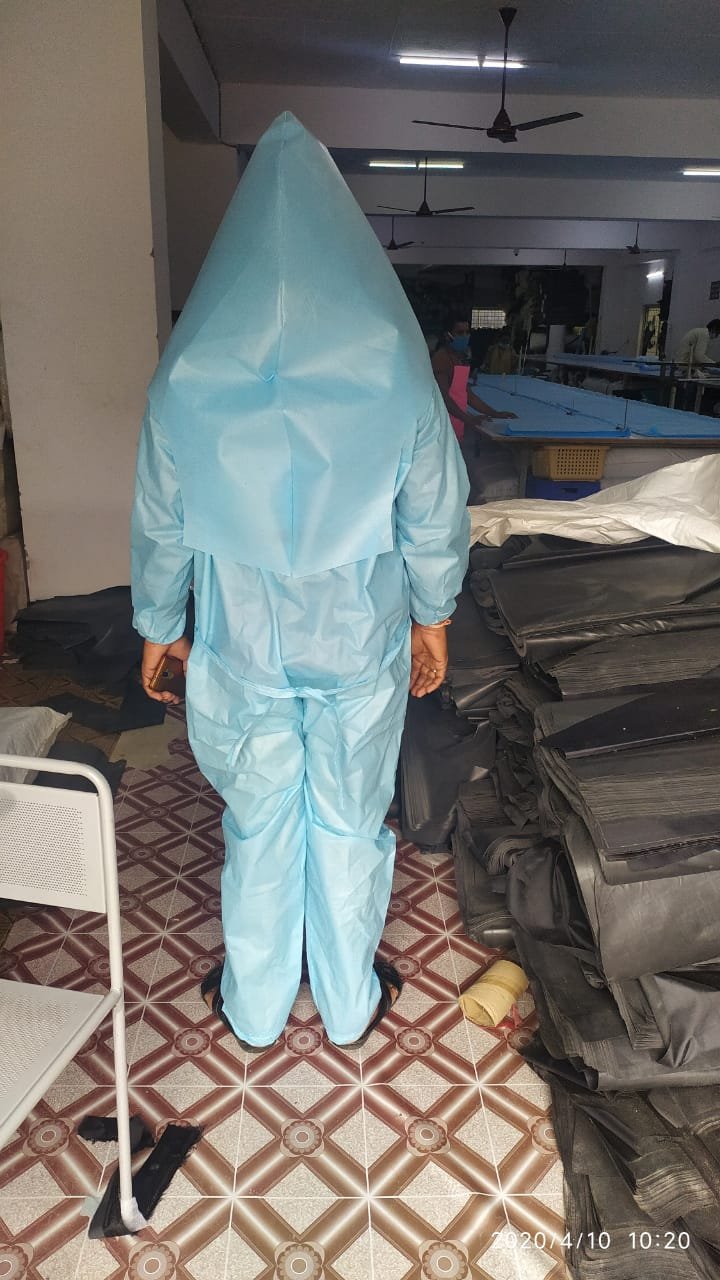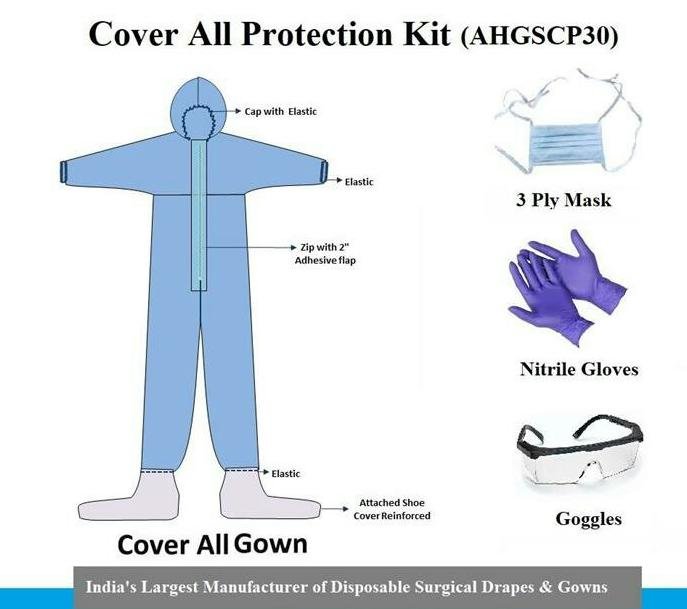PUTTING ON PPE
Before putting on PPE, bear in mind that you may be wearing the equipment in a warm environment for an extended period of time. To minimize discomfort during patient care, use the restroom before putting on PPE. You should also make sure you are hydrated. If you wear prescription eyeglasses, make sure they are secure on your face.
PPE should be put on near the patient’s room, in a clean room or a marked area in the hallway. Clean PPE should also be stored in this area.
Before entering the area where PPE is put on, change into scrubs and ensure that a trained observer is available. Change into washable shoes, secure long hair or bangs, and ensure that all personal items (e.g., jewelry, pagers, and cell phones) have been removed.
Enter the PPE-donning area and visually check the integrity of the equipment. The trained observer will use a checklist to review the correct sequence of events and read aloud a description of the procedure for putting on PPE.
Before handling any PPE, clean your hands with an alcohol-based hand rub. When your hands are dry, put on the first pair of gloves. Next, sit down and put on boot coverings over your washable shoes.
Insert your arms through the sleeves of the gown, ensuring that the cuff of each inner glove remains under the sleeve. Place your head through the opening at the neck, if the gown has such an opening. Overlap the left and right sides of the gown at the back, and secure the ties. The observer may assist you in securing the ties.
Cup the outside of the respirator in your dominant hand, holding the pliable nasal strip at your fingertips and letting the two straps hang freely around your hand. Bring the respirator to your face. Secure the lower strap around the back of your neck, and then secure the upper strap behind your head. Mold the pliable nasal strip around the bridge of your nose. Perform a seal-check. Begin by covering the respirator with your hands and inhaling deeply and quickly several times. The respirator should collapse slightly against your face. Next, place your hands around the edges of the respirator and exhale to determine whether there are any air leaks. If the respirator fails to collapse or if air leaks from the sides, remold the nasal strip and adjust the positioning of the respirator on your face. If you are still unable to obtain a complete seal, consider using a PAPR. Instructions in the use of a PAPR are beyond the scope of this review.
Place the hood over your head, ensuring that it overlaps the gown, covers your head and neck fully, and extends to the shoulders. If you are using an apron, place your head through the opening at the neck. Have the observer secure the ties in the back.
Put on the second pair of gloves. Extend this set of gloves over the sleeves of the gown.
Place the face shield over the hood, letting the cushion rest on your forehead and securing the strap on the back of your head. If your hair is tied in a bun, make sure the strap is positioned in a manner that ensures that the strap will not slide up or down. Adjust the elastic strap if necessary to ensure a snug fit. If you are wearing eyeglasses, adjust all PPE that covers your head to make sure you are comfortable, thereby minimizing the need to readjust your PPE during patient care.
The observer must now verify that the ensemble is intact and ensure that you can move comfortably without compromising the integrity of the PPE. Disinfect your outer gloves with an alcohol-based hand rub. You are now ready to enter the patient’s room.
REMOVING PPE
The proper removal and disposal of contaminated PPE is the most difficult challenge in preventing inadvertent exposure to pathogens; careful attention is required, and persons who wear prescription eyeglasses should make sure their glasses are not contaminated when they remove PPE. Removal of PPE should take place in an anteroom or doffing area that is separate from the patient’s room. These areas are considered to be contaminated and are separate from the clean area used for putting on PPE. The PPE-removal area should not be used for any other purpose.
The following equipment should be available in the anteroom: clean gloves, an alcohol-based hand rub, one chair clearly identified as “dirty” for the removal of shoe coverings, a second chair designated as “clean” to be used for the disinfection of washable shoes, disinfectant wipes registered by the Environmental Protection Agency (EPA) for use in health care, and a leakproof container designated for the disposal of biohazardous waste for disposable equipment. If any reusable equipment is used, a second biohazardous waste container should be available to hold such equipment.
Before leaving the patient’s room, use an EPA-registered disinfectant wipe to disinfect any visible contamination on your PPE. Disinfect your outer gloves with an alcohol-based hand rub and allow your gloves to dry.
A trained observer must be available in the anteroom to supervise the PPE-removal process. The observer should use a checklist that remains in the anteroom and watch carefully for any breach in protocol. It is important for the observer to wear a fluid-resistant or impermeable gown, a full face shield, two pairs of gloves, and impermeable boot coverings. You may enter the PPE-removal area when the observer so indicates.
Once in the anteroom, conduct another inspection of your PPE and disinfect any visible contamination with a disinfectant wipe. An EPA-registered disinfectant spray can be used on heavy contamination if permitted by your institution. Disinfect your outer gloves with an alcohol-based hand rub.
If wearing an apron, break the strap behind your back, and then break the strap that secures the apron around your neck. Pull the apron away from your body, and then roll it inside-out, as shown in the video. Discard the apron in the biohazardous waste container.
Inspect your PPE again for visible contamination or tears. If visual contamination remains, wipe the area again with a disinfectant wipe. Disinfect your gloves.
Sit down on the chair designated as “dirty” to remove your boot covers. Grasp the heel of one cover and slowly pull it off your leg and foot. Avoid touching your scrubs and shoes. Dispose of the boot covering in the biohazardous waste container. Repeat with the other boot covering. Afterward, stand up, step away from the dirty chair, and disinfect your outer gloves.
Remove the outer gloves by grasping the glove on one hand with the other hand. Grasping the exterior of the glove at the wrist, pull the glove off of your hand, with the contaminated exterior folded inside. Hold the removed glove in the double-gloved hand. Slide a single-gloved finger under the wristband of the remaining outer glove. Gently pull off the glove so that it is now inside-out, forming a bag for the other glove, and discard. Disinfect the inner pair of gloves.
Remove the face shield. It is particularly important to avoid contamination of the eyes and mucous membranes when removing facial PPE. Tilt your head forward and lift the shield by the strap. Lift it above and away from your head without touching the shield itself, and discard it in the biohazardous waste container. Disinfect your gloves.
Leaning forward, grasp the hood near the top and carefully pull it off and away from your head. Discard it in the biohazardous waste container, and disinfect your gloves.
Remove your gown by first undoing the fastening at the waist. (The trained observer may assist you in undoing the fastenings at the neck and the back of the gown. This assistance should be agreed upon by you and the observer before patient care. If the observer does assist you in the removal of your equipment, the observer must disinfect his or her outer gloves with an alcohol-based hand rub immediately after contact with your PPE.) Grasp the shoulder area and peel the gown away from your body, turning the gown inside-out and wrapping it into a bundle. Only the interior of the gown should remain visible. Discard the gown, and then disinfect your gloves.
Remove the inner pair of gloves as described for the outer pair, taking precaution to avoid contaminating your bare hands. Use an alcohol-based hand rub for disinfection after taking off the gloves. Put on a new pair of gloves once your hands have dried.
Remove the N95 respirator. To minimize the possibility of contamination, avoid contact with the respirator itself, touching only the straps. Tilt your head forward, grab the strap that is around your neck, and lift it over your head, allowing it to hang freely. Then bring the top strap over your head and use it to remove the respirator from your face. Discard the respirator, then disinfect your gloves.
Sit down on the designated clean chair and use disinfectant wipes to clean all external surfaces of your shoes. Disinfect your gloves.
Remove the last set of gloves as described previously. Disinfect your hands with an alcohol-based hand rub.
The trained observer should conduct a final inspection at this point to identify any contamination of your surgical scrubs. If there is contamination, an occupational safety and health coordinator should be informed immediately before you exit the PPE-removal area. The observer may now be contaminated and should always perform the same PPE-removal procedures as the health care worker before leaving the anteroom.










Reviews
There are no reviews yet.